Category: edci306a
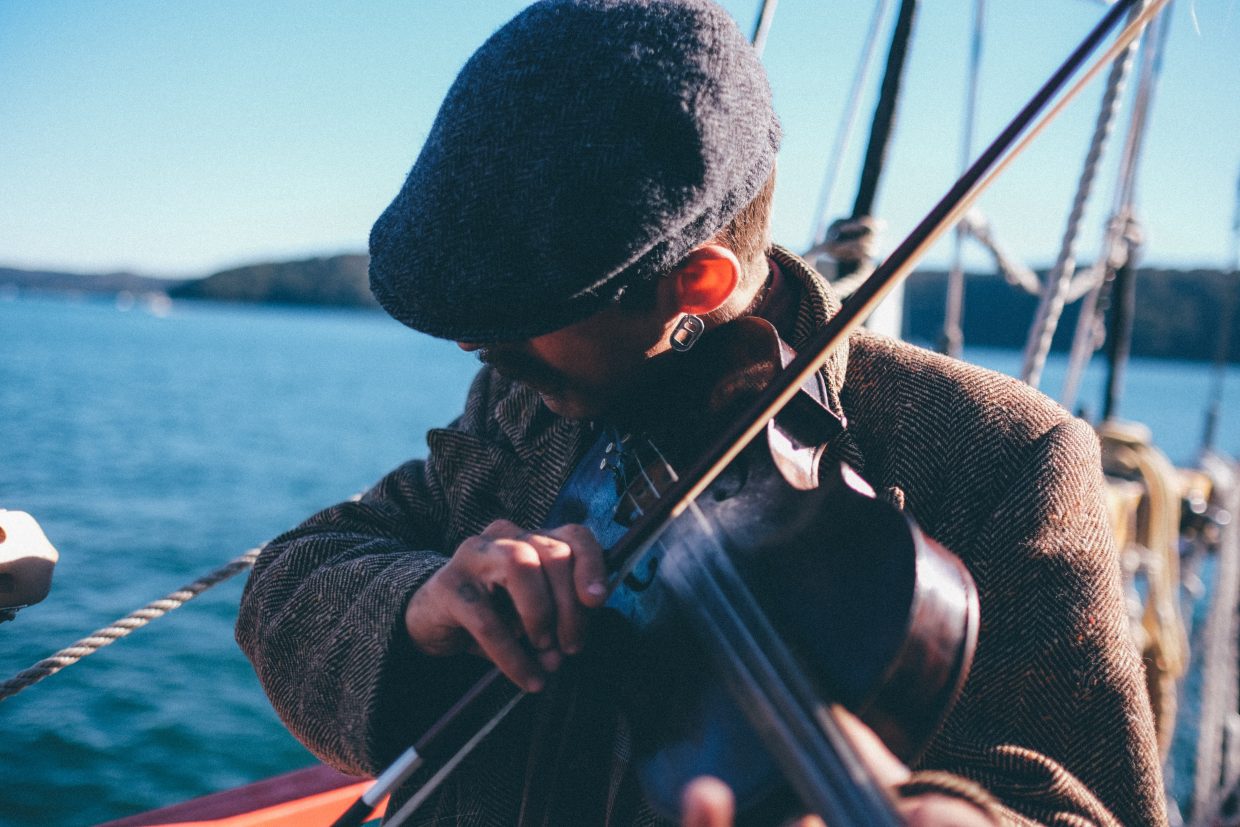
Well, the time has finally come where I must showcase all of my surmounting skills in one video. It has been such an enjoyable journey learning to read music by learning how to play the violin, and I intend to continue practicing and improving my playing so that I may use it in my teaching practice and add to my musical repertoire. I’d like to use this post to summarize the skills I have learned in my path up to this point, what I’ve taken away from my musical growth experience, and my thoughts surrounding my goal. Before September, I had never picked up a violin in my life. I had played guitar and drums recreationally when growing up, but a classical and technical approach was never my forte (just ask my friends). Learning to play music from the ground up on a technical instrument such as the violin hasn’t been easy for me, but it has given me new skills that I am very proud of. The journey itself came with lessons too, not just pertaining to reading and playing music but to how I respond to new challenges and cope with failure. As I reflect, I notice my idealistic goals, and how they may have been slightly lofty. I didn’t actually know everything it would take to learn such a complex piece as a novice violinist, but I couldn’t have really known this until I began the process of learning how to play. I had to learn how to properly hold the violin on my shoulder to keep a healthy posture, and how to hold the bow correctly. I had to understand the complex technique of staying relaxed through the limbs, and where and how to place my fingers on the neck to play certain notes. The amount of knowledge I have gained is quite substantial, and my playing has improved impressively. Now don’t get me wrong, I am still, by all means, a beginner, but a competent beginner. An amateur if you will. The video I post will reflect my beginner status in a few ways: I still find it difficult to accurately finger notes on the neck, and I am not yet able to switch bowing from string to string flawlessly. Despite these important constructive points, I believe that I have, for the most part, reached my goal of learning how to play and interpret the music to “He’s a Pirate” on the violin. My goal was not to play this song at its exact tempo, or without flaws, but to gain the skills to be able to learn it through reading the music and playing it smoothly and recognizably.
In my video, I play my rendition of “He’s a Pirate”, originally by Hans Zimmer.
Thank you for giving me the opportunity to learn a new instrument and to bring more joy into the lives of myself and others.
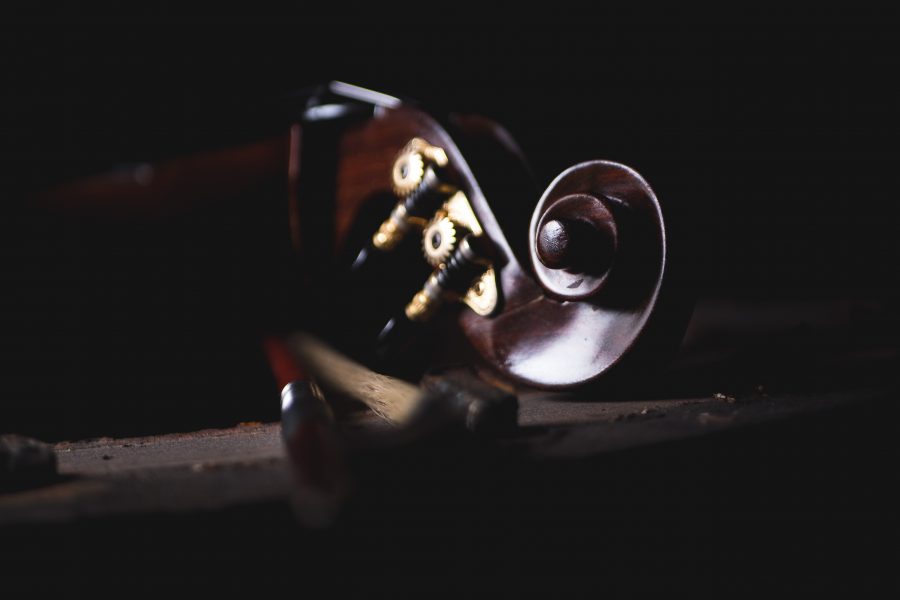
I have now focused my efforts acutely on my final goal of learning “He’s a Pirate“, the theme song from Pirates of the Caribbean. This was the original goal I set back in September, and although I took the option to switch goals to something a little more attainable after the mid term, I haven’t been able to shake the feeling of determination to learn to play this song. It is more technical than any piece I have played before, requiring me to use of all 4 of my fingers on the neck, and to bow on all of the strings. In the past I have only used 3 of my fingers to play songs learned by ear, and only learned to read music involving playing wth one finger. The sheet music I am reading from for this song has features such as slurs, dotted minims, and all sorts of notes and rests. I have taken my time to work through this music, researching what I haven’t yet learned so that I can now confidently interpret it. One of the fundamental things I had to understand was the low and high positions of the fingers, which I had just begun to cover in the last post. After a bit more research on youtube and flipping ahead in my violin instruction book, I now understand the relationship between upper and lower finger positions and the notes they produce. Furthermore, I have just figured out how to read them on a staff. To explain, this picture is taken from the “He’s a Pirate” sheet music(insert pic of time sig with flat on the b line) The flat symbol on the B line of the time signature tells me that the B note that will be played in this measure will be flat. When translated to the neck of the violin, this note is played in the lower 1st finger on the A string, rather than on the regular or upper 1st finger position, which would produce a B note. This picture helps to explain my learning. This is just one of the things I have learned in my attempts to play this song.
In attempts to diversify my learning methods, and to incorporate technology into my inquiry, I decided to use Youtube as a resource to help me learn this song. In all honesty, I would find it very challenging to play the song without having these incredible videos to refer to. There are many different interpretations and versions of He’s a Pirate, but I decided to choose a version that seems challenging, but just enough that I may still be able to pull it off. The only sheet music I have found for this version is included in this youtube video, which has also made it easier to read the notes. Moreover, I found a correlating tutorial video that has helped me to conceptualize and understand the more complex fingering involved. It is important to note that I have chosen to play this song at half its regular speed to make it more suitable for a beginner, however, it remains recognizable. Playing this song perfectly and without making any mistakes is optimal, however it was never stipulated in my learning goal. Having learned the skills to play it well enough that it is recognizable and pleasant sounding is my intention.
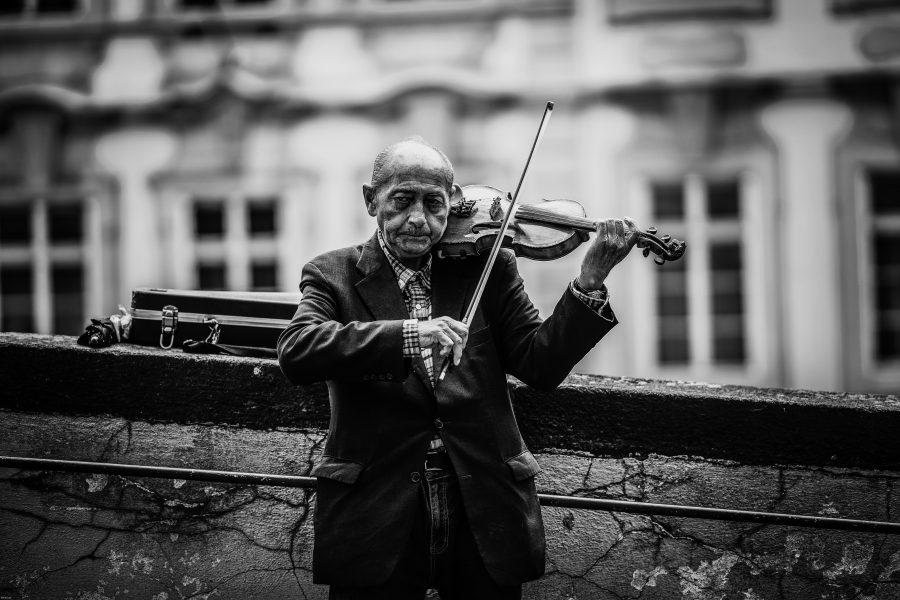
Overall, my experience of learning how to play the violin has been a pleasure. The immediate gratification that I’ve received from playing my first few tunes has been strong and has kept me motivated to learn more. In chapter 10 and 11 of “Violinworks” by Ros Stephen, I have learned how to read and integrate dynamics into my violin playing. Such things as crescendos and diminuendos are more complex to execute on a bowed instrument compared to a drum or guitar. For example to play quietly on a drum, one simply uses less force when striking the skin of the drum, whereas to play loudly one uses more force. This relationship between force and volume is present when playing the violin as well; the more pressure that is placed on the strings by the bow produces a louder sound, and less pressure makes a quieter sound. However, it is not as simple as that, because the speed with which the bow slides across the strings also controls the volume level. This is just one example of how to articulate dynamics on a violin, but it works to show how complex it is to play this instrument.
Chapter 11 introduces using the “high 2nd finger” which eludes to there also being a “low 2nd finger”. This was BIG NEWS to me, as I had been working ahead of the book and using all of my fingers to play by just sounding things out on my own such as “come on Eileen” by Dexy’s Midnight Runners. I thought that instead of frets, there were 4 consecutive notes that corresponded to where the fingers naturally fell on the violin’ neck. What I’d forgotten about were sharps and flats! I can’t say I still completely understand it all yet, but I do know that on the top ‘G’ string on the violin, when the second finger presses down in low position (closer to the scroll), it produces a Bm note, whereas when it presses down in the high position it produces a B. In the book it only teaches to use the high position with the second finger. I may have to research another source to understand all of this better and figure out how to read these notes on a staff.
*I’ve realized that there is not much time left until I am supposed to have reached my learning goal of reading and playing the song “He’s a pirate”. Therefore, I have found the sheet music and begun to learn how to read it. Nervously, I decided to make my goal slightly easier by choosing not to learn “He’s a Pirate” and to learn to read and play two simpler songs, but I am having a hard time taking the easy way out. Let’s see if I can make it happen! If anyone knows where I can get 5 extra hours to add to my day, please let me know. Thanks!
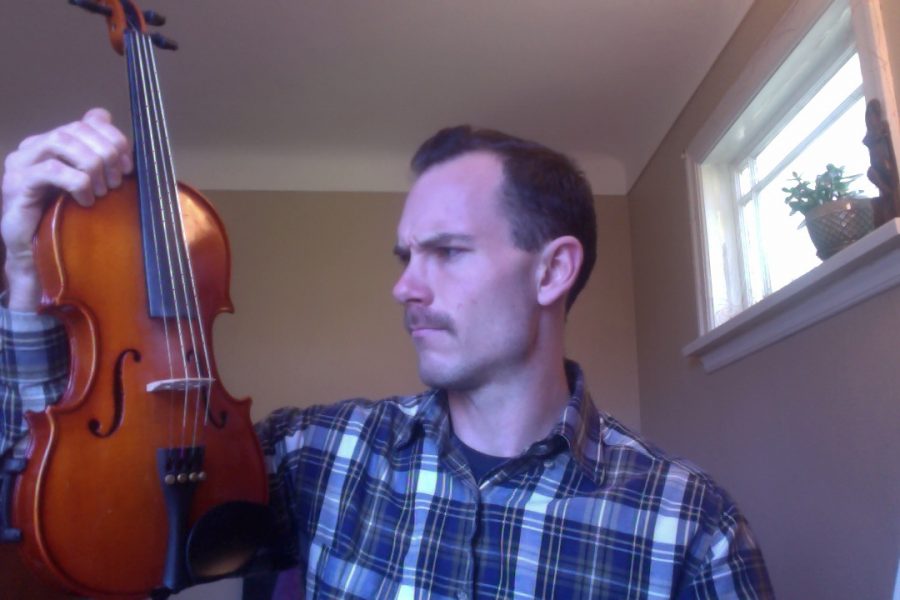
Chapter 7- Intro to the left hand
While moving along through my instruction book (http://violin-works.com), a key point I’ve learned is how to hold my left hand on the neck of the violin; straight from the elbow to the hand, and relaxed, with points of contact on the thumb and the base knuckle of the index finger.
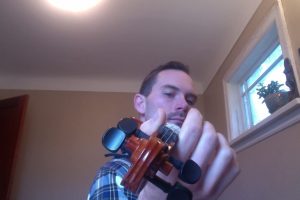
I also read that fret markers are not recommended because the violin is primarily an auditory instrument, where the player should not rely on their vision but their ear to determine if they are playing the right note. I agree with this point and think that it will be better for learning music as a whole if I have to sound things out, so I peeled off my fret marker. Singing the note I am trying to play will help my music sense anyway, rather than taking a more mechanical approach. This chapter also introduced me to tones and semi-tones, as well as intervals, sharps, and flats, but are covered more extensively in chapter 8 and 9.
In Chapter 8 I learned how to swing the left elbow forward and backward under the neck in order to help fingers reach the
G 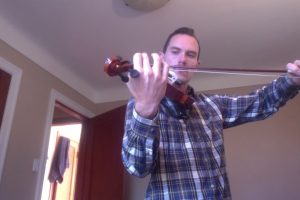
and E 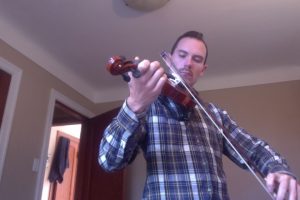 strings.
strings.
I also learned that the 3rd finger notes on each string are all an interval of an octave above the neighboring lower string. Understanding this relationship gives context to how the notes are laid out along the neck. The beginning of ‘Somewhere over the rainbow’ is a good example of playing the same note in a different octave. Watch and listen!
In chapter 9, Stephen further explains tones, semi-tones and minor thirds (Something I still don’t quite understand). I can see now how to read music and interpret where my fingers go on each string. For example, if I were to play an open D string, putting my first finger down on the string would give me an E note. Therefore, if I read an E (on the bottom line of the staff), then I know I’ll need to put my first finger down in the D string. When using my fingers to stop the string on the neck, I am to make sure that I stay relaxed and use only as much pressure as necessary. It is also important to keep all of my fingers just above the string when not in use, and when stopping a string, use the pad of the tip of my finger for accuracy.
Explaining the theory as I learn it gives you a good idea of my progression in a sense, but it doesn’t really tell you about my playing. Therefore I intend to take a little video or sound clip for each new post to track my playing, skill progression and sound. Sometimes I may just play an exercise, and other times I will play songs, but for each, I will explain what I’ve accomplished, and what I may still be struggling with. As of now, keeping my hands relaxed that is a struggle, as they tend to clench up, stiffening my grip on the bow causing it to bounce across the strings. I am going to focus on staying relaxed and slowing things down.
The next chapters involve many new exercises using the fingers of the left hand in the high position and low position (whatever that means). I’m looking forward to learning about what is to come! Until next time!

Hello Anita!
If all you want is to see me play twinkle twinkle little star, fast forward to 5 minutes. I also play “Come on Eileen” by Dexy’s Midnight Runners afterward.

Well, I am a little closer to my goal, but somehow I also feel further away. The further I dive into learning how to play the violin, the more I realize how challenging it truly is! I admit that I may have been a touch over-confident in my earlier assessment of what it would take to learn to play the violin, however that doesn’t mean that I am any less confident about reaching my goal. It just means that it’s going to be more challenging than I thought! In my last post, I covered some of what I learned about the basics of the violin, like how to keep proper posture and tune the strings. In this post, I describe my experience working through chapters 4, 5, and 6 of “Violinworks” by Ros Stephen (http://violin-works.com), as well as the details of my practice up to this point. Since my first post, I’ve been able to put my theoretical knowledge to the test by finally picking up the bow and trying my best to produce a good clean sound. What I’ve learned is that holding the bow properly, keeping proper angles and alignment with the strings, and remaining relaxed are all very difficult to do, especially when focusing on all of them at once. I am able to run the bow along a string smoothly if I am to focus solely on my contact point, but as I begin to shift my focus to the placement of my left hand on the neck, I notice my bowing form suffers. I suppose that practicing each of these skills individually is important as a beginner, and as the muscle memory starts to take shape, things will sound better. However, this requires patience and discipline to practice rudiments skills rather than attempting to play more exciting pieces of music, something a fairly intermediate guitar player like myself doesn’t like to do.
My music reading, on the other hand, has improved greatly! The repetition of reading from my instruction book, practicing in class and teaching drum lessons on the weekend has got me more confident than I’ve ever been. I’ve got a strong base, and now I am ready to read more into the different notes and strings specific to violin sheet music.
I still have not looked at the sheet music for “He’s a pirate”, but I have been practicing two songs by ear. Working these out has been fun, and definitely helped with learning the spatial awareness of the notes on the neck. The first is twinkle twinkle little star, which sounds good when played fast or slow, and incorporates playing on multiple strings. The second, I was inspired to learn because I love the song and because the violin solo in the introduction was fairly easy to sound out. With that, it is safe to say that my roommates are extremely tired of hearing my scratchy, barely recognizable rendition of ‘Come on Eileen’ by Dexy’s midnight runners, but I certainly am not! This song uses all of the strings and incorporates long and short strokes which makes it very fun to play. I have sounded it out in a different key than the original, but it still sounds proper. I will play what I can of this song as well as twinkle twinkle in my video to show my progress.
In chapters 7-13 of my instruction book, the focus shifts from bowing to using the left hand, and to how to properly utilize each individual finger. I’m going to try to progress a little bit faster than I have so far in the semester by working through the book a little bit quicker. I hope to have read to Chater 10 by next week. Wish me luck!
Thanks for reading!

I am excited to say that I have just taken my first steps on my journey to becoming a violin aficionado! Okay, maybe not an aficionado, but baby steps right? In this post, I will outline briefly what I’ve learned thus far and what I plan to learn in this coming week.
To support my learning and set myself up for success, I decided to purchase a musical instruction book to aid in my practice. Titled “Violinworks: A comprehensive method for the older beginner” (http://violin-works.com), author Ros Stephen organizes lessons within chapters, beginning with Chapter 1; the anatomy of the violin and bow, the names of the strings and how to tune them, as well as the fingering references (numbers assigned to fingers). Key points I took away from this chapter was that unlike a guitar, the strings are tuned using mainly the “fine tuners” located at near the tailpiece, rather than the pegs located near the neck. It’s also very important when changing the strings, not to remove all of the strings at once for one risks collapse of the bridge and/or soundbar. Most things learned from this chapter pertain to preparing to play the violin and not actually playing it. For example, I also learned that it is important to tighten the bow hair before playing and to loosen it when finished, and also to run the hair of the bow over rosin 3 to 4 times before playing. Rosin is made from pine resin, which when applied, makes the bow slightly sticky so that it grips the strings, causing them to vibrate as the bow is drawn across them.
It was in Chapter 2, “Holding the Violin and Playing Pizzicato” that I began to actually use the violin, but not before I learned the basic posture required. If I were to summarize this chapter with one word, it would have to be “Relax”, because ironically it is something that is quite stressed. I soon found out why, as it must be common for beginners to tense up and become rigid when first trying to play. The violin is actually very light in weight, so you dont really need to hold it up with your hand because the weight of your head on the chinrest does just that. You’re meant to just support it very lightly, while using the neck as an anchor for your hand and fingers. I tried my best at remaining relaxed and assuming the proper posture with my shoulders back, then holding the violin on my neck/shoulder and proceeding to play pizzicato. What’s pizzicato? It’s the italian word for “picked” or “plucked” which refers to a way of playing the violin that doesn’t involve using the bow, but simply plucking the strings with one’s fingers. I learned that you can do this not just with the index finger of your right hand (bow hand), but with the pinky finger of your left hand on the neck. I played using each hand, while maintaining a steady rhythm plucking each of the open strings. It came to me quite easily and left me thirsty for more.
Chapter 3 is titled “Notation, Pulse and Rhythm” and looks as though it will begin to explain how to read music, while chapter 4, 5, and 6 explain how to properly use the bow. I plan to work through these chapters over the coming week so that I can begin to practice developing a feel for playing the violin, and move one step closer to achieving my goal of learning the song “He’s a Pirate” from Pirates of the Caribbean. Thank you very much for reading!
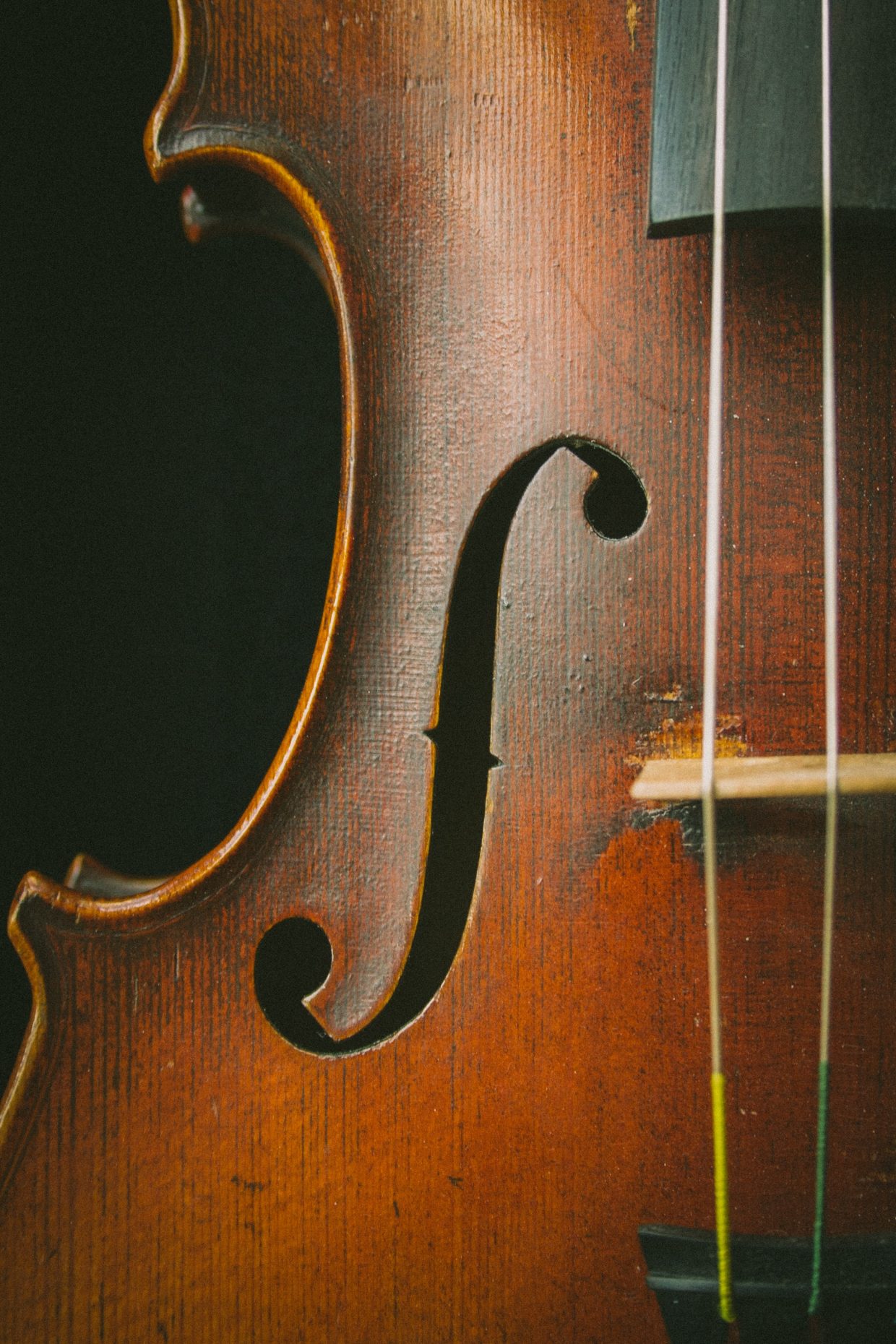
As a young teenager, one of my greatest inspirations was music. From watching ‘Much Music’ countdown on T.V., to purchasing my first CD’s I quickly became infatuated with the dazzling allure of rock and roll, and the escape that music offered from the world. With influences like Led Zeppelin, the Red Hot Chili Peppers, and Shinedown, it wasn’t long before I was gifted my first guitar from my Dad and began my musical journey. Learning how to play the guitar wasn’t so much about the proper posture or music theory for me, but about recreating the sounds that had stirred my soul and spoke to my adolescent emotions. I thought is was so cool that I could play the same riffs that i saw Jimmy Page or Jimmy Hendrix play on stage. I took it upon myself to sound out songs and eventually learn how to read tablature, opening the doors to endless amounts of my favorite songs and guitar riffs. This decision- learning how to play the guitar- has brought me so much joy over the years, offering me a way to express myself artistically and connect with people in a profound way. I wouldn’t be the same person if I didn’t play the guitar; it has become a part of who I am.
It’s clear to see the impact that playing a musical instrument can have. Why wouldn’t we all want to learn how to play an instrument?
In our music class this semester we have been tasked with a free inquiry project labeled “Musical Growth Plan”. It requires us to come up with a plan to achieve a specific musical goal. We have the option to learn something totally new, or progress a skill we already have. This project is very exciting to me, and has inspired multiple ideas; learning the didgeridoo, exploring African drumming, and playing guitar as part of a classroom lesson are all interests of mine that I hope to get the opportunity to explore on the future. However, I have chosen to do my musical growth project on learning how to play the violin because I think it’s a unique instrument that has lost popularity and has a classic and timeless sound. No doubt this will be a challenging feat, and while learning any instrument has its challenges, I have heard that the violin can be especially difficult. I am prepared to face these demands, and hoping that my experience playing the guitar will carry me through to achieve my ambitious and most exciting goal of playing the famous ‘Pirates of the Caribbean’ song “He’s a Pirate”. I suspect that learning how to use a bow will be my greatest challenge to start, but despite whatever setbacks may lie in my way, I am looking forward to beginning my journey of equipping myself with another musical skill, and another tool for expressing myself to the world.
